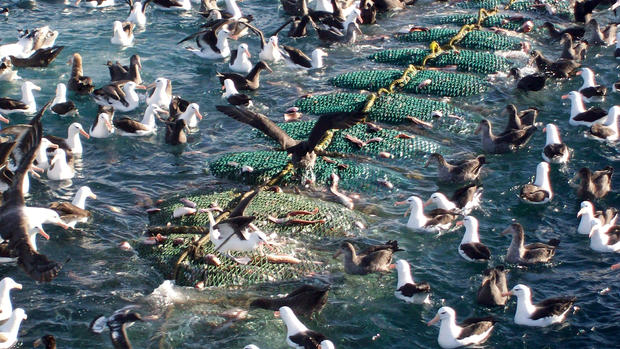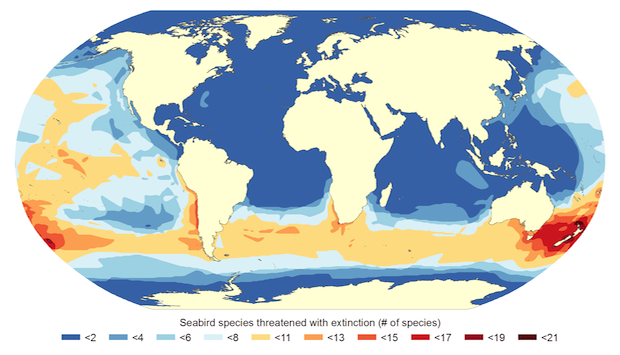Seabirds suffering massive population declines
Consider the albatross.
A bird that mates for life and flies over 6,000 miles for food, the albatross has seen profound population declines over the past several decades. It appears now as though a harbinger for its own demise.
Or take the Fiji petrel, a black, tube-nosed bird that spends almost its entire life skimming the oceans. The petrel, the albatross and other birds suffer when the oceans are polluted and overfished and a new study in PLOS One suggests they are paying a heavy price. Since the 1950s, the study concludes that seabird numbers have dropped by nearly 70 percent.
"Seabirds are particularly good indicators of the health of marine ecosystems," said University of British Columbia's Michelle Paleczny, a co-author of the study and a researcher with the Sea Around Us project. "When we see this magnitude of seabird decline, we can see there is something wrong with marine ecosystems. It gives us an idea of the overall impact we're having."
For the study, the researchers compiled information on more than 500 seabird populations from around the world, representing 19 percent of the global seabird population. They found overall populations had declined by 69.6 percent or the equivalent to a loss of about 230 million birds in 60 years.
Some of worst drops were in the Southern Hemisphere, which includes Australia, Antarctica, most of South America and a third of Africa. Among the families hardest hit have been Sternidea, which includes terns and saw declines of 85.8 percent. That was followed by Frigatidae, a family which includes frigatebirds and saw declines of 81.7 percent. Then there was Procellariidae, a family that includes petrels and saw declines of 79.6 percent and Phalacrocoracida, a group that includes cormorants and shags, saw drops of 73.6 percent.
The family of Diomedeidae, which includes albatross, saw declines of 69 percent.
"We are seeing a serious and worrying decline," said Rory Crawford, a senior policy officer with BirdLife International's marine Programme, which in 2012 estimated that nearly half of seabird populations were in trouble.
"It's a large number of species across a number of families that are in decline and that is alarming," he said. "This is not about going to one location. It's about a broad range of threats effecting sea birds."
The study concluded that the dramatic declines were caused by a range of factors, including overfishing of the fish seabirds rely on for food. Hundreds of thousands of birds each year get tangled in fishing gear and die or are sickened by oil spills or plastic pollution. They also face threats to their colonies from invasive predators such as rats that feast on their eggs. Other factors include destruction and changes to seabird habitat as well as the environmental and ecological changes caused by climate change.
They are especially vulnerable because of their dependence of a wide swath of open water for food, traveling the world's oceans to forage for food and returning to the same colonies to breed.
George Wallace, vice president for oceans and islands at the American Bird Conservancy, said the impacts especially on long-distance fliers like the petrels and shearwaters shows just how much "humans have altered the planet."
"They may be responding to oceanic conditions that are thousands of miles from their breeding colonies," he said. "If you are a Hawaiian petrel that undertakes a foraging flight that literally takes up most of the northern Pacific Ocean and you don't find food, that is a tremendous exertion of energy and a chick that won't be fed."
A big part of the problem, Paleczny said, was the absence of efforts to protect many of these birds.
"Our work demonstrates the strong need for increased seabird conservation effort internationally," Paleczny said. "Loss of seabirds causes a variety of impacts in coastal and marine ecosystems."
Crawford agreed, saying increased efforts should be made to rid seabird colonies of invasive species, reduce bycatch, or the ensnaring of birds in fish nets, and setting up conservation areas for all aspects of the birds' life cycles from breeding sites to migratory routes.
"There are things we can do. What we need is investment and support of governments around the world to make this happen," Crawford said. "These actions will build resilience in the seabird populations in the short term, which they need in the face of climate change."
In a sign of hope, some bird populations have increased their numbers. A group called Hydrobatidae, which includes storm petrels, saw its numbers rise more than 45 percent while the family of Alcidae, which includes puffins and murres, climbed 9.1 percent.
The researchers didn't explain why some groups appeared to be thriving or whether this reflected all species within the groups, although it could be attributed to successful efforts to rid several Pacific islands of cats, rats and other invasive species.
And in another conservation success, Birdlife recently worked with fishermen in South Africa to reduce bycatch by 99 percent and thus give a boost to the albatross.
"What I'm encouraged about is that we know what the solutions are," Crawford said. "We know the seabirds will respond spectacularly well if we remove invasive species from their breeding colonies. We know that we can reduce seabird bycatch in fisheries with simply measures that are not costly and don't affect the efficiencies of the fishery operation."



